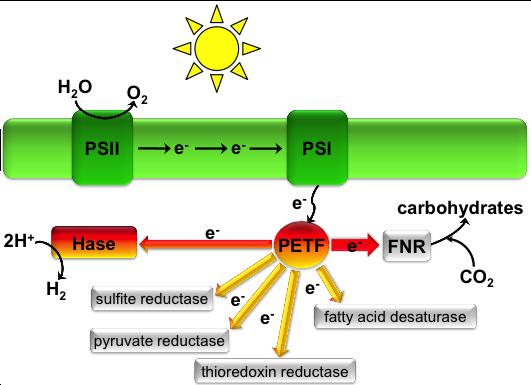Efficient production of hydrogen by algae

Electrontransfer in the alga C. reinhardtii, that leads to the production of hydrogen or other substances. Hase = Hydrogenase. © MPI CEC / RUB
However, in order to make hydrogen production by microalgae economically feasible their efficiency has to be increased by 1-2 orders of magnitude. In the current issue of Energy and Environmental Science scientists from the AG Photobiotechnology of the Ruhr University Bochum and the Max Planck Institutes in Mülheim present how an improvement in efficiency can be achieved.
Microalgae use light-energy to extract electrons from water during photosynthesis. Most of these electrons are transported by a small, iron-containing protein, the ferredoxin PETF, to the protein ferredoxin-NADP+-oxidoreductase (FNR), which feeds the electrons into the production chain of carbohydrates.
PETF passes only a small fraction of the electrons to other proteins like the Hydrogenase. This protein is a very powerful enzyme, whose amino acid chain harbours a unique six-iron cluster, in which electrons (e-) are transferred to protons (H+) to produce hydrogen (H2).
Using nuclear magnetic resonance spectroscopy (NMR) the scientists investigated in great detail which amino acids of PETF interact with Hydrogenase and which with FNR. Thereby they identified two amino acids of PETF with negatively charged side chains that are ex-clusively important for binding FNR.
The directed genetic modification of exactly those two residues to amino acids with uncharged side chains led to an increased production of hy-drogen. Together with further modifications of the FNR this resulted in a five-fold increased rate for hydrogen production.
The knowledge-based change of electron transfer pathways has the potential to make fur-ther enhancements of hydrogen production possible. The efficiency necessary for an eco-nomic application of biological hydrogen production can probably be achieved by the com-bination of different modifications.
Thus, the presented results are important for the devel-opment of an environmentally friendly, regenerative energy supply that does not depend on expensive and rare noble metals.
Further information
The link to the publication in Energy and Environmental Science:
http://pubs.rsc.org/en/content/articlelanding/2014/ee/c4ee01444h
Dr. Sigrun Rumpel, Max Planck Institute for Chemical Energy Conversion in Mülheim an der Ruhr, Tel. 0208/3063895, sigrun.rumpel@cec.mpg.de, www.cec.mpg.de
Dr. Martin Winkler, Lehrstuhl für Biochemie der Pflanzen, Ruhr Universität, 44780 Bochum, Tel. 0234/3227049, martin.winkler-2@rub.de
http://www.cec.mpg.de/media/Presse/2014/PM_EES_english_SR_ER_WL_final_es.pdf
Media Contact
All latest news from the category: Life Sciences and Chemistry
Articles and reports from the Life Sciences and chemistry area deal with applied and basic research into modern biology, chemistry and human medicine.
Valuable information can be found on a range of life sciences fields including bacteriology, biochemistry, bionics, bioinformatics, biophysics, biotechnology, genetics, geobotany, human biology, marine biology, microbiology, molecular biology, cellular biology, zoology, bioinorganic chemistry, microchemistry and environmental chemistry.
Newest articles

A universal framework for spatial biology
SpatialData is a freely accessible tool to unify and integrate data from different omics technologies accounting for spatial information, which can provide holistic insights into health and disease. Biological processes…

How complex biological processes arise
A $20 million grant from the U.S. National Science Foundation (NSF) will support the establishment and operation of the National Synthesis Center for Emergence in the Molecular and Cellular Sciences (NCEMS) at…

Airborne single-photon lidar system achieves high-resolution 3D imaging
Compact, low-power system opens doors for photon-efficient drone and satellite-based environmental monitoring and mapping. Researchers have developed a compact and lightweight single-photon airborne lidar system that can acquire high-resolution 3D…





















